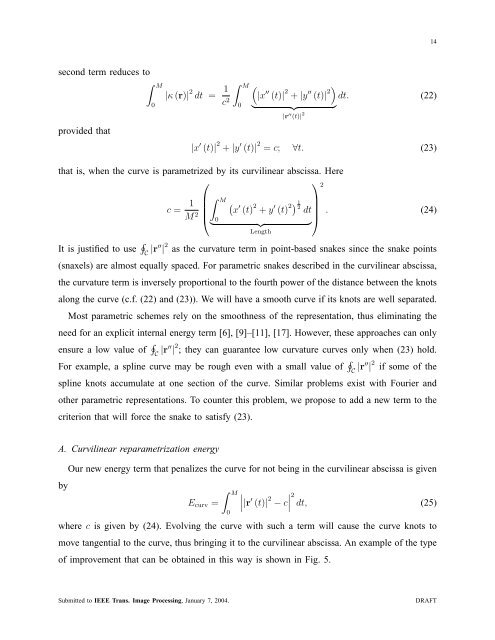Efficient energies and algorithms for parametric snakes - EPFL
Efficient energies and algorithms for parametric snakes - EPFL
Efficient energies and algorithms for parametric snakes - EPFL
Create successful ePaper yourself
Turn your PDF publications into a flip-book with our unique Google optimized e-Paper software.
14second term reduces to∫ Mprovided that0|κ (r)| 2 dt = 1 ∫ M (|x ′′ (t)| 2 + |y ′′ (t)| 2)c 20} {{ }|r ′′ (t)| 2 dt. (22)|x ′ (t)| 2 + |y ′ (t)| 2 = c; ∀t. (23)that is, when the curve is parametrized by its curvilinear abscissa. Here⎛⎞2c = 1∫ M(⎜ x ′ (t) 2 + y ′ (t) 2) 12 dt⎟. (24)M 2 ⎝ 0⎠} {{ }LengthIt is justified to use ∮ C |r′′ | 2 as the curvature term in point-based <strong>snakes</strong> since the snake points(snaxels) are almost equally spaced. For <strong>parametric</strong> <strong>snakes</strong> described in the curvilinear abscissa,the curvature term is inversely proportional to the fourth power of the distance between the knotsalong the curve (c.f. (22) <strong>and</strong> (23)). We will have a smooth curve if its knots are well separated.Most <strong>parametric</strong> schemes rely on the smoothness of the representation, thus eliminating theneed <strong>for</strong> an explicit internal energy term [6], [9]–[11], [17]. However, these approaches can onlyensure a low value of ∮ C |r′′ | 2 ; they can guarantee low curvature curves only when (23) hold.For example, a spline curve may be rough even with a small value of ∮ C |r′′ | 2 if some of thespline knots accumulate at one section of the curve. Similar problems exist with Fourier <strong>and</strong>other <strong>parametric</strong> representations. To counter this problem, we propose to add a new term to thecriterion that will <strong>for</strong>ce the snake to satisfy (23).A. Curvilinear reparametrization energybyOur new energy term that penalizes the curve <strong>for</strong> not being in the curvilinear abscissa is givenE curv =∫ M0∣∣|r ′ (t)| 2 − c∣ 2 dt, (25)where c is given by (24). Evolving the curve with such a term will cause the curve knots tomove tangential to the curve, thus bringing it to the curvilinear abscissa. An example of the typeof improvement that can be obtained in this way is shown in Fig. 5.Submitted to IEEE Trans. Image Processing, January 7, 2004.DRAFT
















